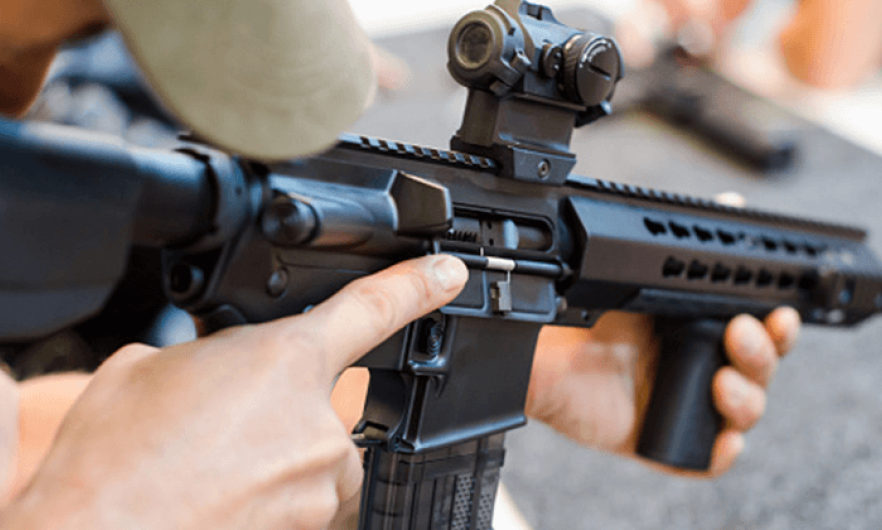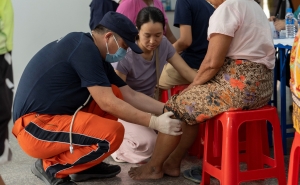Policies That Reduce Gun Violence: Restricting Large Capacity Magazines

Reducing the number of mass shootings and related deaths requires limiting access to weapons that facilitate them.
The uniquely American phenomenon of public mass shootings occurs with almost numbing frequency.
Mass shooting fatalities make up the fastest-growing category of gun-related deaths. Mass shootings commonly involve firearms with large capacity magazines (LCMs). Shootings with the most casualties often involve firearms that not only accept LCMs but facilitate the ability to shoot many people within a short span of time: what are commonly known as assault weapons.
The 10-year Federal Assault Weapons Ban that expired in 2004 banned the manufacture and sale of semiautomatic assault weapons and LCMs. Currently, seven states and Washington, D.C., ban the two devices, and two states, Colorado and Vermont, only restrict LCMs.
In this Q&A, Daniel Webster, ScD ’91, MPH, director of the Center for Gun Violence Prevention and Policy, explains the association between LCMs, assault rifles, and mass shootings, and why a reinstatement of the federal ban on such devices—along with other restrictive measures—could reduce the death counts of mass shootings.
This Q&A is adapted, with updates, from Webster’s presentation at Policies that Work to Reduce Gun Violence, a September 2019 forum highlighting science and policy solutions to the nation’s epidemic of gun violence.
What are large capacity magazines (LCMs) and assault weapons?
LCMs are ammunition feeding devices that can hold more than 10 rounds of ammunition. Definitions of assault weapons can vary across state laws but are generally defined as semiautomatic firearms that can accept LCMs and typically have one or more other features commonly associated with or designed more for military or criminal purposes. These may include pistol grips, folding stocks, or barrel shrouds that facilitate a very rapid fire of the gun in a very short period of time.
What is known about how these weapons are used for criminal purposes?
Shockingly, none of our [federal crime reporting] systems track the use of these types of firearms in violent crime in the United States. What we have to go on is crime gun trace data from the Bureau of Alcohol, Tobacco, Firearms, and Explosives. We know that 5% of guns traced to crime and recovered by law enforcement are categorized as assault weapons.
Christopher Koper, who has done some of the landmark research on the use of assault weapons in crime, finds that assault weapons are used in 10%–30% of fatal mass shootings, and they account for 13% of killings of law enforcement officers in the line of duty.
With LCMs, the only thing we have to go on now is the handful of cities that track the ammunition capacity of firearms connected to crimes. Dr. Koper’s research found that 22%–36% of the firearms used in crimes recovered by law enforcement had large capacity magazines, and LCMs are involved in 20%–67% of fatal mass shootings. That is a broad range because data on the ammunition capacity of firearms used in mass shootings is often missing.
What does the research say about the use of these devices in mass shootings?
In a 2020 paper, Dr. Koper found that fatal mass shootings with LCMs have 60%–67% higher fatality counts and 100%–200% higher wounding counts than mass shootings without LCMs. A study that looked at active-shooter scenarios [found that] the use of an assault rifle with an LCM had twice as high fatality counts and 81% higher numbers of victims with nonfatal gunshot wounds than in shootings committed with other types of firearms.
How effective are restrictive gun laws/assault weapons bans in preventing mass shootings?
There have been a very limited number of studies that have been designed to look at very specific gun laws and their association with fatal mass shootings, and they have had mixed results and a variety of limitations. This motivated our team at Johns Hopkins to do a new study looking at the firearm policies and fatal mass shootings.
We identified over 600 mass shootings—defined as [having] four or more victims—from 1985 to 2017, with 2,976 deaths. (Interestingly, some of the biggest mass shootings that have driven policy discussions were actually excluded from the FBI system.) We found no statistically significant association between the Federal Assault Weapons Ban and this outcome, nor did we find a statistically significant reduction for state bans of assault weapons.
We think a reason that we’re not seeing impacts from the laws is that there are alternatives like assault weapons that were “grandfathered” (not covered by bans on new sales) and, with state bans, assault weapons purchased from states without assault weapon bans.
What did you learn about the effect of LCM bans on mass shootings?
We found very encouraging effects. Our estimate was that laws that ban large capacity magazines are associated with a 49% lower rate of fatal mass shootings. On a per capita basis, we see a 70% lower rate of individuals killed in mass shootings associated with state bans of LCMs.
What would the most effective laws and policies be to stop the use of assault weapons LCMs?
The evidence indicates that bans on both the sale and possession of LCMs would reduce the number of fatalities from mass shootings substantially. Enforcement of these laws should be examined to ensure the laws are being applied in an equitable and just manner.
The more challenging question is, “What do we do about assault weapons?” The available evidence suggests that they play an important role in some of the worst fatal mass shootings. There’s not a justifiable reason for civilians to have military-style weapons like assault weapons, but right now we’re not seeing the policy solutions that are having an effect. It’s a challenge to tightly regulate and restrict these types of firearms that are available, given how many we already have.
Finally, it’s important to note that the policy most strongly associated with reductions in fatal mass shootings is licensing for firearm purchasers.
Daniel Webster, ScD ’91, MPH, is director of the Center for Gun Violence Prevention and Policy and a Bloomberg Professor of American Health in Health Policy and Management.





